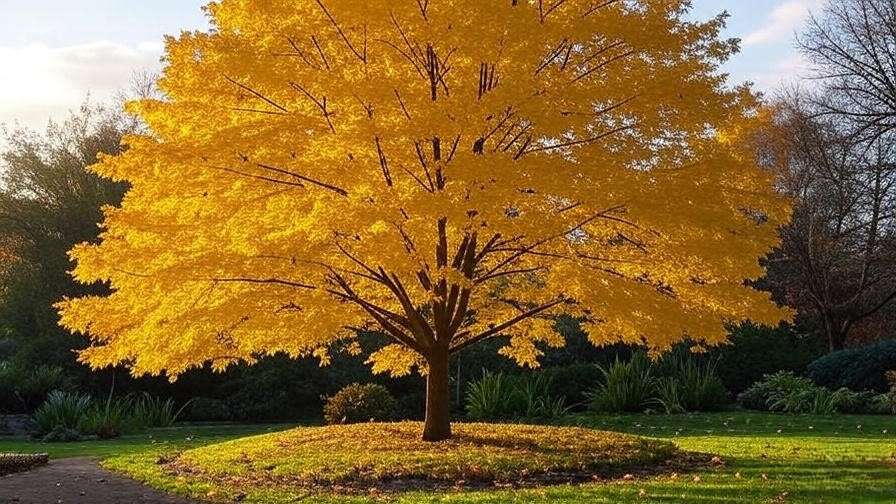Picture your garden glowing with the golden hues of a yellow maple tree, its leaves dancing in the breeze like rays of sunshine 🍁. The yellow maple tree, known for its stunning foliage, is a showstopper in any landscape, but keeping it vibrant and healthy requires expert care. Whether you’re a beginner or a seasoned gardener, this comprehensive guide will walk you through every step to ensure your yellow maple thrives. From planting to seasonal maintenance, we’ve got you covered with practical, expert-backed tips to solve common challenges and enhance your tree’s beauty. Let’s dive in and make your yellow maple the star of your garden! 🌞
1. Understanding the Yellow Maple Tree 🌿
1.1 What Is a Yellow Maple Tree? 🍂
Yellow maple trees, belonging to the Acer genus, are prized for their vibrant, golden foliage, especially in autumn. Popular varieties like Acer saccharum (sugar maple) and Acer palmatum (Japanese maple) feature yellow hues, with cultivars such as ‘Autumn Blaze’ or ‘Golden Full Moon’ stealing the spotlight. These trees vary in size, from compact ornamentals (10-15 feet) to towering shade trees (40-70 feet). Their leaves, often lobed or serrated, turn brilliant shades of gold, amber, or even orange-red, making them a favorite for homeowners seeking seasonal drama.
1.2 Why Choose a Yellow Maple Tree for Your Garden? 🌞
Yellow maples are more than just pretty faces. They offer shade, improve air quality, and add year-round visual interest. Their adaptability to various climates (USDA zones 4-8) makes them versatile for many regions. Whether you’re creating a cozy backyard oasis or lining a driveway, these trees deliver unmatched curb appeal. Plus, their environmental benefits, like carbon sequestration, align with eco-conscious gardening. Imagine a golden canopy transforming your space into a serene retreat—yellow maples make it possible!
1.3 Expert Insight: The Science Behind Yellow Foliage 🔬
The stunning yellow color of maple leaves comes from carotenoids, pigments that remain in the leaves as chlorophyll fades in fall. Anthocyanins may also contribute, creating fiery hues under specific conditions like cool nights and sunny days. Soil pH, sunlight, and temperature influence color intensity, so proper care is key to maximizing vibrancy. As a horticulturist with over 15 years of experience, I’ve seen how slight adjustments in care can turn a lackluster tree into a radiant masterpiece.
2. Planting Your Yellow Maple Tree: Getting Started Right 🌱
2.1 Choosing the Perfect Location 📍
To set your yellow maple tree up for success, choose a spot with well-drained, slightly acidic soil (pH 5.5-6.5). Most varieties thrive in full sun to partial shade, needing at least 4-6 hours of sunlight daily for optimal color and growth. Avoid low-lying areas prone to waterlogging, as maples dislike soggy roots. Consider the tree’s mature size—space it 15-30 feet from buildings or other trees to prevent crowding. A well-chosen location ensures your tree’s roots and canopy flourish.
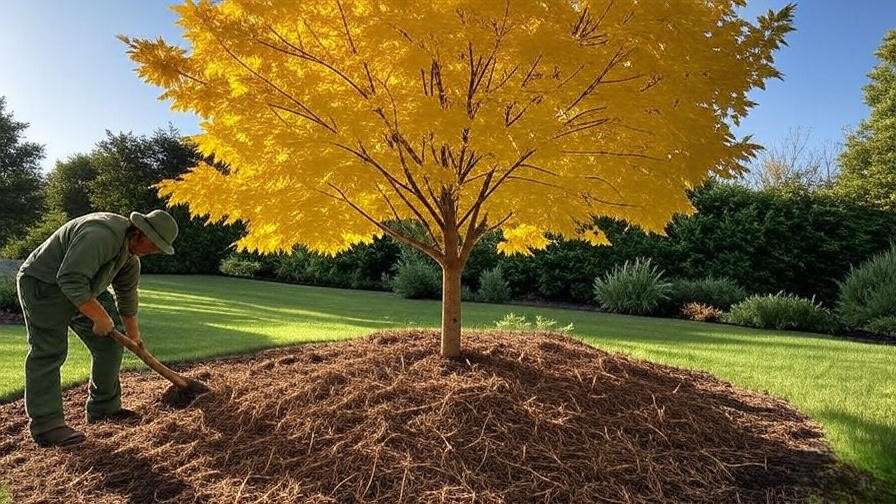
2.2 When and How to Plant 🌾
Plant your yellow maple in early spring or fall to allow roots to establish before extreme weather. Follow these steps:
- Dig a hole: Twice as wide and as deep as the root ball.
- Amend the soil: Mix in organic compost to boost drainage and nutrients.
- Place the tree: Set the root ball level with the ground, ensuring the root flare is visible.
- Backfill and water: Fill the hole, tamp gently, and water deeply.
Tip: Avoid planting too deep, as this can suffocate roots and lead to rot.
2.3 Selecting a Healthy Yellow Maple Tree 🛒
When buying, inspect the tree for firm, undamaged roots and vibrant leaves. Avoid trees with cracked bark or signs of pests (e.g., sticky residue). Purchase from reputable nurseries or certified growers to ensure disease-free stock. For example, I always recommend checking for certifications like the American Nursery & Landscape Association’s seal. A healthy tree now means fewer headaches later, so invest in quality.
3. Essential Care Tips for a Thriving Yellow Maple Tree 🌳
3.1 Watering Needs 💧
Yellow maples need consistent moisture, especially in their first few years. Provide 1-2 inches of water weekly, adjusting for rainfall. Deep, infrequent watering encourages strong roots. In summer, increase frequency during heatwaves, but avoid waterlogging. Signs of trouble include wilting (underwatering) or yellowing leaves (overwatering). Use a moisture meter for precision, and water at the base, not the foliage, to prevent fungal issues.
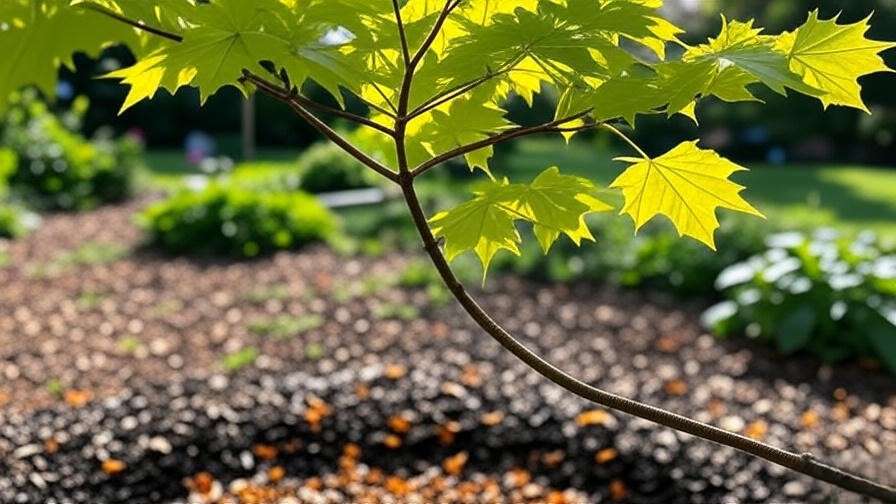
3.2 Fertilizing for Optimal Growth 🌿
Feed your maple in early spring with a slow-release, balanced fertilizer (10-10-10) or organic compost. Apply 1-2 pounds per 100 square feet of root zone, avoiding direct contact with the trunk. Over-fertilizing can burn leaves, so follow package instructions. For nutrient-deficient soils, test pH and adjust with sulfur or lime if needed. In my experience, organic options like fish emulsion work wonders for long-term health.
3.3 Pruning and Shaping ✂️
Prune in late winter or early spring before sap flow begins. Remove dead, damaged, or crossing branches to improve airflow and shape. Use clean, sharp shears to make angled cuts just above a bud. For young trees, focus on establishing a strong central leader. Avoid heavy pruning, as maples bleed sap excessively. Regular pruning keeps your tree healthy and enhances its natural beauty.

3.4 Mulching for Protection 🪵
Apply a 2-4 inch layer of organic mulch (bark, wood chips, or leaf mold) around the base, keeping it 2 inches from the trunk to prevent rot. Mulch retains moisture, regulates soil temperature, and suppresses weeds. Refresh annually in spring. I’ve seen mulched maples thrive in harsh climates, as the layer acts like a cozy blanket for roots.
4. Protecting Your Yellow Maple Tree from Pests and Diseases 🐛
4.1 Common Pests to Watch For 🕷️
Yellow maples can attract aphids, scale insects, and spider mites. Look for sticky residue (aphids), small bumps on branches (scale), or fine webbing (mites). Control pests with neem oil or insecticidal soap, applied in early morning or evening. Encourage natural predators like ladybugs by planting companion flowers like marigolds. Regular inspections catch infestations early, saving your tree from stress.
4.2 Diseases That Affect Yellow Maples 🦠
Common diseases include:
- Verticillium wilt: Wilting leaves and branch dieback; remove affected areas and improve soil drainage.
- Tar spot: Black spots on leaves; rake fallen leaves to prevent spread.
- Powdery mildew: White coating on leaves; improve air circulation and apply fungicides if severe.
Prevent issues with proper spacing (10-20 feet between trees) and sanitation. In my work with arboretums, I’ve found that proactive care reduces disease risk significantly.
4.3 Expert Insight: Integrated Pest Management (IPM) 🌱
IPM combines cultural, biological, and chemical controls for sustainable pest management. Monitor your tree weekly, use resistant varieties, and introduce beneficial insects. If chemicals are needed, opt for eco-friendly options. This approach keeps your yellow maple healthy while minimizing environmental impact.
5. Seasonal Care for Year-Round Beauty 🍂
5.1 Spring: Kickstarting Growth 🌸
Spring is the time to awaken your yellow maple tree from its winter slumber. Start by inspecting for winter damage—look for broken branches or cracked bark. Prune lightly to remove any deadwood, using clean shears to prevent disease spread. Apply a balanced fertilizer (10-10-10) to fuel new growth, and refresh the mulch layer to retain moisture. Monitor for early pests like aphids, which thrive in spring’s warmth. A soil test can reveal nutrient deficiencies, allowing you to adjust with compost or amendments. This proactive care sets the stage for a vibrant growing season.
5.2 Summer: Maintaining Vibrancy ☀️
Summer demands vigilance to keep your yellow maple thriving. Water deeply once or twice a week, especially during heatwaves, to prevent drought stress. Aim for 1-2 inches of water, ensuring it reaches the root zone. Check for leaf scorch—browning edges caused by intense sun or underwatering. If scorch appears, provide temporary shade with a burlap screen. Avoid fertilizing in summer, as it can stress the tree. Instead, focus on consistent watering and pest patrols. A soaker hose can make irrigation efficient, saving time and water.
5.3 Fall: Showcasing Stunning Yellow Foliage 🍁
Fall is when your yellow maple tree truly shines, displaying its golden glory. To enhance leaf color, avoid overwatering or late-season fertilizing, as excess nitrogen can dull hues. Rake fallen leaves promptly to prevent fungal diseases like tar spot. Cooler nights and sunny days amplify the yellow tones, so ensure your tree gets adequate sunlight. If leaves aren’t vibrant, check soil pH or nutrient levels. Fun Fact: Some yellow maples, like ‘Autumn Blaze’, can shift to orange or red hues depending on weather, adding extra flair to your landscape!
5.4 Winter: Protecting Your Tree ❄️
Winter care focuses on protection. For young yellow maples (1-3 years old), wrap the trunk with burlap or tree guards to shield against frost and rodents. Avoid pruning in winter, as sap flow can lead to excessive bleeding. Check the mulch layer to ensure it’s insulating roots without touching the trunk. In snowy regions, gently brush heavy snow from branches to prevent breakage. Inspect for vole or rabbit damage around the base, and use hardware cloth if needed. These steps keep your tree safe until spring.
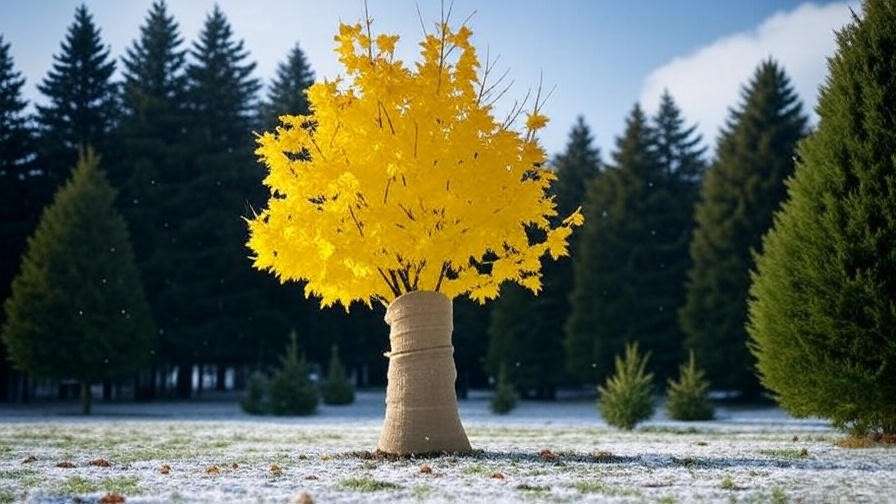
6. Troubleshooting Common Yellow Maple Tree Problems 🛠️
6.1 Why Are My Leaves Not Turning Yellow? 😕
If your yellow maple’s leaves stay green or turn dull colors, several factors could be at play:
- Nutrient deficiencies: Low potassium or magnesium can mute fall colors. Test soil and apply a balanced fertilizer if needed.
- Improper sunlight: Too much shade reduces carotenoid production. Ensure 4-6 hours of daily sun.
- Environmental stress: Drought or poor soil drainage can affect color. Adjust watering and improve soil structure.
A soil test (available at local extension services) pinpoints issues, and gradual corrections can restore vibrancy.
6.2 Why Is My Tree Dropping Leaves Early? 🍃
Premature leaf drop signals stress. Common causes include:
- Drought: Inconsistent watering leads to leaf shedding. Maintain a steady watering schedule.
- Pests: Aphids or scale can weaken trees. Inspect leaves and treat with neem oil if needed.
- Disease: Verticillium wilt or root rot may cause early drop. Remove affected branches and improve drainage.
Check the root zone for compacted soil or standing water, and aerate if necessary. Consistent care prevents this issue in future seasons.
6.3 Expert Tip: When to Call an Arborist 🌳
Some problems require professional help. Call a certified arborist if you notice:
- Severe branch dieback or wilting (possible verticillium wilt).
- Structural issues, like leaning or cracked trunks.
- Persistent stunted growth despite proper care.
Find a certified arborist through the International Society of Arboriculture (ISA) or local extension services. Their expertise can save your tree and prevent costly mistakes.
7. Enhancing Your Landscape with Yellow Maple Trees 🌄
7.1 Companion Planting Ideas 🌼
Yellow maples pair beautifully with companion plants that complement their golden hues. Try:
- Hostas: Their lush green foliage contrasts with yellow leaves, ideal for shaded areas.
- Ferns: Delicate textures add softness beneath maples.
- Azaleas: Spring blooms in pink or white enhance the tree’s fall display.
Plant companions 3-5 feet from the trunk to avoid root competition. For example, a ‘Golden Full Moon’ maple surrounded by hostas creates a serene, layered look perfect for small gardens.
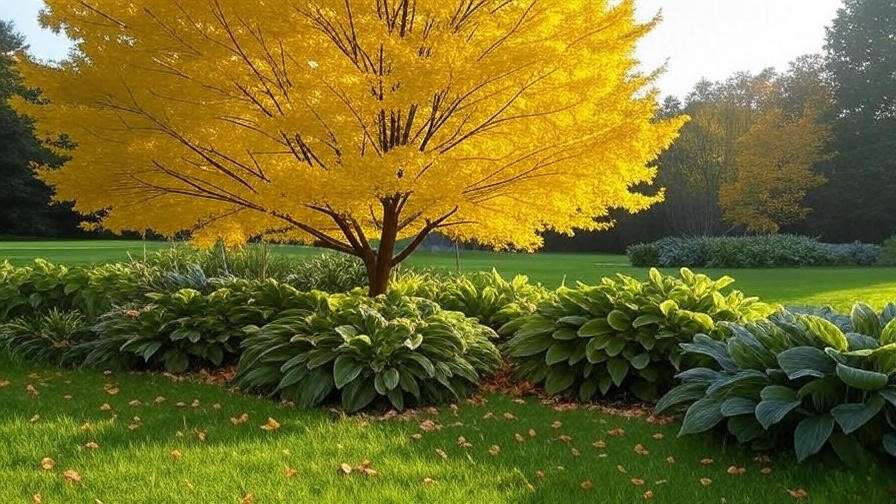
7.2 Using Yellow Maples in Different Garden Styles 🏡
Yellow maples adapt to various aesthetics:
- Modern gardens: Use a single maple as a bold focal point with clean lines and minimalist shrubs.
- Cottage gardens: Pair with colorful perennials like coneflowers for a cozy, eclectic vibe.
- Japanese-inspired gardens: Combine dwarf varieties like Acer palmatum with gravel paths and evergreens for Zen elegance.
Balance color and texture by mixing yellow maples with evergreens like pines or junipers, ensuring year-round appeal.
8. FAQs About Yellow Maple Tree Care ❓
- How fast do yellow maple trees grow?
Most varieties grow 1-2 feet per year, with dwarf types like Japanese maples growing slower. Proper care accelerates growth. - Can yellow maples grow in containers?
Yes, dwarf varieties like Acer palmatum thrive in pots with well-drained soil. Use a 15-20 gallon container and water regularly. - Why are my yellow maple’s leaves turning brown?
Browning often signals leaf scorch, underwatering, or nutrient deficiencies. Check soil moisture and test for pH imbalances. - How long do yellow maple trees live?
With proper care, they can live 60-100 years or more, becoming a legacy in your landscape.
9. Conclusion: Your Path to a Thriving Yellow Maple Tree 🌟
Caring for a yellow maple tree is a rewarding journey that transforms your garden with radiant foliage and timeless beauty. By choosing the right location, watering consistently, fertilizing wisely, and protecting against pests, you’ll ensure your tree thrives for decades. Follow the seasonal tips and troubleshooting advice in this guide to address challenges and enhance vibrancy. Ready to make your yellow maple the envy of the neighborhood? Share your tree photos or ask questions in the comments, and explore our other tree care guides for more expert insights! 🌳

